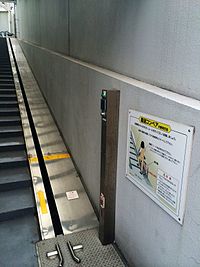
A bicycle, also called a pedal cycle, bike, push-bike or cycle, is a human-powered or motor-assisted, pedal-driven, single-track vehicle, with two wheels attached to a frame, one behind the other. A bicycle rider is called a cyclist, or bicyclist.
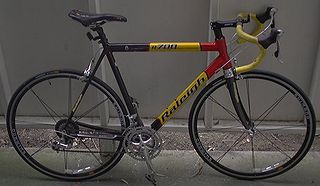
The term road bicycle is used to describe bicycles built for traveling at speed on paved roads. Some sources use the term to mean racing bicycle. Other sources specifically exclude racing bicycles from the definition, using the term to mean a bicycle of a similar style but built more for endurance and less the fast bursts of speed desired in a racing bicycle; as such, they usually have more gear combinations and fewer hi-tech racing features. Certain of these bicycles have been referred to as 'sportive' bicycles to distinguish them from racing bicycles.

A tandem bicycle or twin is a form of bicycle designed to be ridden by more than one person. The term tandem refers to the seating arrangement, not the number of riders. Patents related to tandem bicycles date from the mid 1880s. Tandems can reach higher speeds than the same riders on single bicycles, and tandem bicycle racing exists. As with bicycles for single riders, there are many variations that have been developed over the years.

The penny-farthing, also known as a high wheel, high wheeler or ordinary, is an early type of bicycle. It was popular in the 1870s and 1880s, with its large front wheel providing high speeds, owing to it travelling a large distance for every rotation of the legs, and comfort, because the large wheel provided greater shock absorption.
Indoor cycling, often called spinning, is a form of exercise with classes focusing on endurance, strength, intervals, high intensity and recovery, and involves using a special stationary exercise bicycle with a weighted flywheel in a classroom setting. When people took cycling indoors in the late 19th century, whether for reasons of weather or convenience, technology created faster, more compact and efficient machines over time. The first iterations of the stationary bike ranged from the vertical Gymnasticon to regular bicycles on rollers.

A racing bicycle, also known as a road bike is a bicycle designed for competitive road cycling, a sport governed by and according to the rules of the Union Cycliste Internationale (UCI).

A single-speed bicycle is a type of bicycle with a single gear ratio. These bicycles are without derailleur gears, hub gearing or other methods for varying the gear ratio of the bicycle.
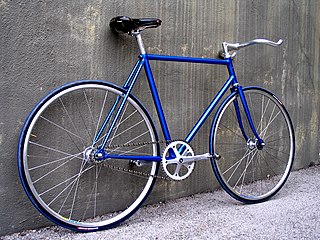
A fixed-gear bicycle is a bicycle that has a drivetrain with no freewheel mechanism such that the pedals always will spin together with the rear wheel. The freewheel was developed early in the history of bicycle design but the fixed-gear bicycle remained the standard track racing design. More recently the "fixie" has become a popular alternative among mainly urban cyclists, offering the advantage of simplicity compared with the standard multi-geared bicycle.

Vehicles that have two wheels and require balancing by the rider date back to the early 19th century. The first means of transport making use of two wheels arranged consecutively, and thus the archetype of the bicycle, was the German draisine dating back to 1817. The term bicycle was coined in France in the 1860s, and the descriptive title "penny farthing", used to describe an "ordinary bicycle", is a 19th-century term.

The track stand or standstill is a technique that bicycle riders can use to maintain balance while their bicycle remains stationary or moves only minimal distances. The technique originated in track cycling and is now used by other types of cyclists wishing to stop for a short time without putting a foot on the ground, such as bike commuters at stop signs. To perform a track stand, a cyclist holds the cranks in an approximately horizontal position with the front wheel steered to the left or right, and pedals forward, and back in the case of a fixed-gear bicycle, which the steered front wheel converts into a side-to-side motion.

This is a glossary of terms and jargon used in cycling, mountain biking, and cycle sport.
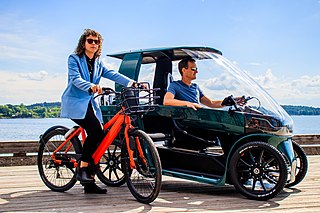
An electric bicycle, e-bike, electrically assisted pedal cycles, or electrically power assisted cycles is a motorized bicycle with an integrated electric motor used to assist propulsion. Many kinds of e-bikes are available worldwide, but they generally fall into two broad categories: bikes that assist the rider's pedal-power and bikes that add a throttle, integrating moped-style functionality. Both retain the ability to be pedaled by the rider and are therefore not electric motorcycles. E-bikes use rechargeable batteries and typically are motor-powered up to 25 to 32 km/h. High-powered varieties can often travel more than 45 km/h (28 mph).

Bicycle performance is measurable performance such as energy efficiency that affect how effective a bicycle is. Bicycles are extraordinarily efficient machines; in terms of the amount of energy a person must expend to travel a given distance, cycling is calculated to be the most efficient self-powered means of transportation.
The following outline is provided as an overview of and topical guide to transport:

Bicycle suspension is the system, or systems, used to suspend the rider and bicycle in order to insulate them from the roughness of the terrain. Bicycle suspension is used primarily on mountain bikes, but is also common on hybrid bicycles.
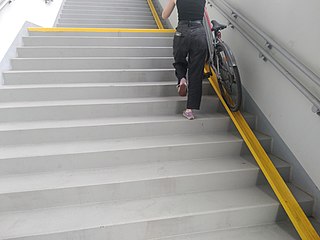
A bicycle stairway is a pedestrian stairway which also has a channel alongside it to facilitate walking a bicycle up or down the stairway.

The following outline is provided as an overview of and topical guide to bicycles:
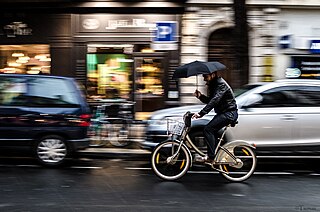
Cycling is a common means of transportation, sport, and recreation in Paris, France. As of 2021, about 15% of trips in the city are made by bicycle, taking place on over 1,000 km (620 mi) of cycling paths. The Tour de France, the largest sporting event in cycling, finishes on the Champs-Élysées. Four major recreational cycling routes—EuroVelo 3, Avenue Verte, the Seine à Vélo, and the Veloscenic—pass by Notre-Dame Cathedral.

Cycling in the United Kingdom has a long history, since the earliest days of the bicycle, and after a decline in the mid-20th century has been undergoing a resurgence in recent decades.


